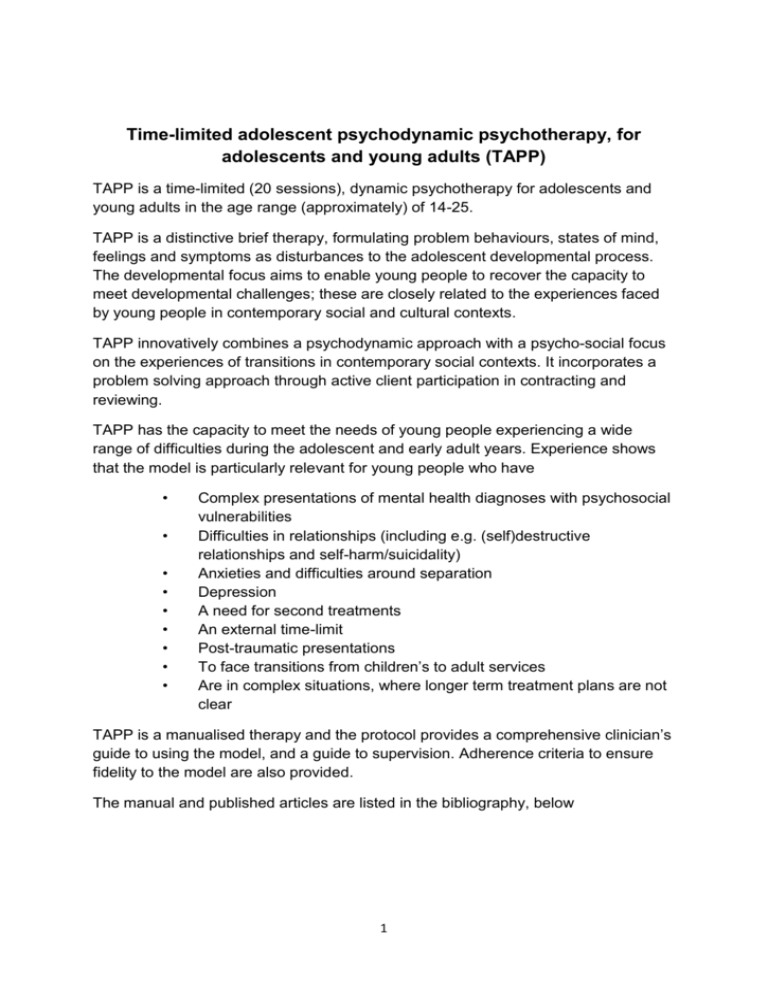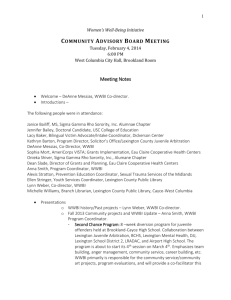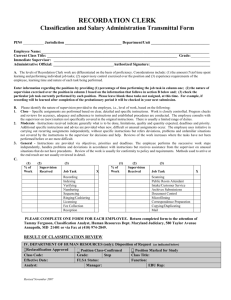TAPP - Stephen Briggs Consulting
advertisement

Time-limited adolescent psychodynamic psychotherapy, for adolescents and young adults (TAPP) TAPP is a time-limited (20 sessions), dynamic psychotherapy for adolescents and young adults in the age range (approximately) of 14-25. TAPP is a distinctive brief therapy, formulating problem behaviours, states of mind, feelings and symptoms as disturbances to the adolescent developmental process. The developmental focus aims to enable young people to recover the capacity to meet developmental challenges; these are closely related to the experiences faced by young people in contemporary social and cultural contexts. TAPP innovatively combines a psychodynamic approach with a psycho-social focus on the experiences of transitions in contemporary social contexts. It incorporates a problem solving approach through active client participation in contracting and reviewing. TAPP has the capacity to meet the needs of young people experiencing a wide range of difficulties during the adolescent and early adult years. Experience shows that the model is particularly relevant for young people who have • • • • • • • • • Complex presentations of mental health diagnoses with psychosocial vulnerabilities Difficulties in relationships (including e.g. (self)destructive relationships and self-harm/suicidality) Anxieties and difficulties around separation Depression A need for second treatments An external time-limit Post-traumatic presentations To face transitions from children’s to adult services Are in complex situations, where longer term treatment plans are not clear TAPP is a manualised therapy and the protocol provides a comprehensive clinician’s guide to using the model, and a guide to supervision. Adherence criteria to ensure fidelity to the model are also provided. The manual and published articles are listed in the bibliography, below 1 Practitioner training in TAPP Overview: Practitioner training involves three elements, or modules: 2 days introductory teaching/learning of the TAPP model and method: preparation for practice Supervised practice of 2 TAPP cases 3 days reflective workshops linking theory and practice To complete the practitioner training, participants will be expected to complete all three modules including the assessments as in the diagram below: Intro • TAPP model and method: 2 day introductory teaching • assessment exercises • Supervised practice of 2 TAPP cases • clinical assessments Supervision • 3 days clinical reflective workshops: • Reflective self-assessment exercise Workshops Who is the course suitable for? The course is suitable for qualified health professionals such as mental health nurses, occupational therapists, clinical and counselling psychologists, psychiatrists, social workers, counsellors, psychotherapists, practising in health, education and social care settings and in private practice. It is suitable for therapists working in all therapeutic modalities. Participants are usually registered with HCPC, BACP, UKCP or BCP. What are the training selection criteria? Candidates should be qualified health professionals (as above) They should have undertaken a relevant course of study and have a good working knowledge of psychoanalytic and other theories underpinning the development of personality. They should have a minimum of 1 years’ experience working therapeutically with young people in teams or in individual or group work. 2 They should have undertaken supervised practice and be committed to professional standards and practice within an ethical framework. Where candidates who are qualified and experienced health professionals but have not had (a) recent psychodynamic experience/training or (b) work with young people an additional requirement is to undertake the preliminary one-day training course, Psychodynamic theories of adolescent development and therapeutic change (for TAPP) – see Appendix 1 below. What does the training consist of? 1. Introductory training (2 days) The introductory training consists of two days teaching/learning which may be taken on consecutive days or on two separate days within one month. These two days may be taken as a ‘stand-alone’ course for CPD purposes. The training provides an overview of the TAPP model and a detailed exploration of the key components of the model, linked to the key skills needed to work effectively with TAPP These are: Applying psychodynamic theories of adolescent development in contemporary contexts The role of observation Assessing for TAPP, including identifying a developmental treatment focus across the age range (14-25 years) Applying relevant understanding of psycho-social and cultural contexts for young people and their development Contracting with the young person Working with different mental health needs and difficulties in young people including ‘internalising’ and ‘externalising’ problems Achieving the therapeutic stance and working with transference and counter transference Working with the developmental focus Working in depth and identifying change and growth Processes of ending and review 3 Training methods The course combines presentations of key aspects of the TAPP model with a case focussed approach, through following the experiences of (fictionalised) young people in TAPP, to link practice experiences with the principles and framework of TAPP. The course is interactive and participative throughout, using group discussion and exercises including case discussion and role play. Key information is provided through short presentations. Programme Day 1: Overview, TAPP model and assessment 9.30 registration and introductions 10-11 overview of TAPP: key principles of the model and the approach to therapeutic change 11.30 -1 Change through development in context: applying psychodynamic developmental theory to the needs and difficulties of young people in contemporary social and cultural contexts 2-3.15 Assessing for TAPP 3.30- 4.30 The contracting process 4.390 5 Review of the day Day 2: TAPP treatment 9.30- 9.45 Catch up, issues, reflections and questions 9.45 - 11 Key aspects of TAPP intervention/treatment: therapeutic stance, transference/counter-transference 11.30 – 1 Working with the developmental focus 2-3.15 Working in depth; change and growth 3.30- 4.30 Endings and post-treatment review 4.30-5; Course review Assessment is through: 1. a structured case comprehension exercise. Three case vignettes are presented with questions to address clinical and theoretical issues central to the TAPP method 4 2. a brief reflective account of the participant’s assessment of their learning on the training and an evaluation of their development and future training needs/focus 2.Supervised practice of working with TAPP cases Following the introductory training, participants are expected to undertake a minimum of 2 cases whilst having weekly supervision. Each case will be seen for the 16 sessions of TAPP, following the 4 sessions of assessment. Detailed criteria for supervision processes and procedures form the basis of the supervision contract, which includes: Supervision may be provided in small groups of three to four students or individual, face – to-face or through Skype. Selection of suitable cases will be undertaken in consultation with the supervisor, the course overall tutor and the participant’s organisation (as appropriate). Supervisors will be selected by the TAPP training committee i.e. in conjunction with organisations collaborating with Stephen Briggs Consulting to deliver the training. Each TAPP session is recorded in full either by process or audio recording. The method of recording will be agreed between supervisor and participant and recorded in the supervision contract (together with the consents for audio recording if used). *Normally, supervisors should be BPC clinical practitioner registrants [psychoanalytic psychotherapy/ psychoanalysis/Jungian analysis category], with 5 years post qualification experience and with extensive experience of the TAPP model. *’Normally’ in the context of this document means that this should be the required level of practitioner, and equivalence would need to be assessed by the TAPP training committee. Assessment consists of: A. A portfolio of three complete sessions for each of the two cases, using either process notes or transcriptions of audio recording B. A case study of one case (3000 words) C. A supervision report completed by the supervisor and student together with the supervisor’s recommendation to the training committee 5 3.Clinical Reflective workshops At intervals whilst undertaking supervised practice participants will attend a minimum of 3 day workshops aiming to provide reflective learning linking theory and practice and the participant’s experience of TAPP. The workshops will consist of case-based discussions (clinical seminars) and the study of key theoretical and technical issues relating to cases. Workshop formats are generated by participants and staff jointly to address issues and to ensure the content relates closely to clinical experiences. Working with core elements of the TAPP model will underpin the workshop content, including working with transference/counter transference, and the developmental focus. Workshops will follow the cycle of TAPP intervention, including therefore: engagement and contracting, assessing, developing and discussing the developmental focus, working with transference/counter transference, recognising change, working with the time limit, ending and reviewing. A typical workshop could be structured by: Introductions/agenda setting Small group case discussions Explorations linking clinical, technical and theoretical issues Assessment: Participants will identify key learning issues from their experience of the TAPP practitioner training and write a reflective account linking clinical experience from their supervised practice, theory and personal experience (2000 words) TAPP Supervisor accreditation To achieve accreditation as a TAPP supervisor, candidates are required to: complete the TAPP Practitioner training undertake and satisfactorily complete two additional supervised cases provide recommendations from a line manager and previous TAPP supervisor about suitability to supervise TAPP cases undertaken supervision of a minimum of three TAPP cases, with monthly consultation from an approved TAPP supervisor, and provide a recommendation from this supervisor attend a half-day CPD workshop on TAPP supervision Requirements for running a TAPP training programme In order to become a TAPP trainer the individual will have successfully completed the following: 1. Practitioner level qualification in DIT as specified by British Psychoanalytic Council (BPC), the accrediting body. 6 2. Supervisor level accreditation, which involves successfully completing a further 2 supervised cases. 3. Working alongside an experienced trainer to deliver the full TAPP course. Structures TAPP training is delivered by Stephen Briggs Consulting1 in collaboration with practice and academic organisations nationally. These include at present: CAMHS in Leicester, Tower Hamlets, Kent (Sussex Partnership), University of East London, nScience UK. *For each TAPP training an agreed protocol for delivery will be agreed between the partners. *Each TAPP training course will have a training committee consisting of (a) experienced TAPP practitioners and trainers normally BPC registrants and eligible to be training therapists and supervisors, (b) representatives of collaborating organisations (c) participant/student representative. *In the appointment of training therapists and supervisors, if the training committee of the TAPP training course consider that there is a suitable applicant who does not meet the stated criteria, they have discretion to look at the individual concerned and appoint them according to their own equivalence criteria. *Graduates will not be registered individually as clinicians by BPC: the accredited TAPP courses will be listed in the BPC register. Graduates may therefore describe themselves as having graduated from a BPC accredited training in TAPP. 1 The Centre for Time Limited Adolescent Psychodynamic Psychotherapy is currently ‘housed’ within Stephen Briggs Consulting www.stephenbriggsconsulting.co.uk 7 Appendix 1 Psychodynamic theories of adolescent development and therapeutic change (for TAPP) This one-day course is for practitioners interested in working with TAPP who have not recently undertaken a course of study in psychodynamic theories of development and theories of therapeutic change and/or working with adolescents.. This prepares participants for participation in the two day training in TAPP (though it may be useful as a stand-alone CPD course). It is a ‘bridging’ day and is not an alternative to the criteria for acceptance on the TAPP practitioner training. Course aims: The course aims to provide an introduction to psychoanalytic approaches to development, focussing on the adolescent and early adult years What does the course consist of? The course provides an overview of psychoanalytic developmental theory, focussing on the influence of earlier development on later experiences and relationships. This includes: Current thinking about development infancy and early childhood and its influence on later development . Key concepts, such as transference and counter-transference; understanding defences against pain and anxiety. The role of observation as important for connecting with emotional and relational aspects in interactions and thus as underpinning therapeutic interventions. In applying this framework to adolescent and young adult development the course consists of the following: classic theories of adolescence from a psychodynamic perspective, including Feud, Klein, Winnicott, Anna Freud contemporary psychoanalytic thinking about adolescent development including theories of subjectivation psychosocial theories linking psychoanalytic approaches to wider social contexts to show the linking of psychoanalytic thinking to changing social experiences and contexts Training Methods The course is interactive and participative throughout, using group discussion and exercises including case discussion and role play. Theories are discussed and applied to clinical and non-clinical examples. Key information is provided through 8 short presentations and draws extensively on the book: “Working with Adolescents and Young Adults: A contemporary psychodynamic approach” (S Briggs, Palgrave 2008). 9









